Tourism Planning Environment: Critique & Comparison of Two Papers
VerifiedAdded on 2023/06/09
|9
|1835
|399
Essay
AI Summary
This essay provides a critical analysis and comparison of two discussion papers related to tourism planning. The first paper focuses on promoting investment in the tourism industry in Nepal, while the second paper, from the World Tourism Organization, discusses sustainable tourism for development. The essay evaluates the role of discussion papers in tourism policy formulation, contrasting the region-centric approach of the Nepal paper with the issue-centric approach of the WTO paper. It highlights the importance of considering stakeholder needs and potential opportunities, concluding that discussion papers are crucial tools in the policy planning cycle for fostering economic growth while addressing social and environmental factors. The essay emphasizes the need for carefully crafted tourism policies that consider the challenges and aspirations of all stakeholders, advocating for a consultative approach in policy formulation.
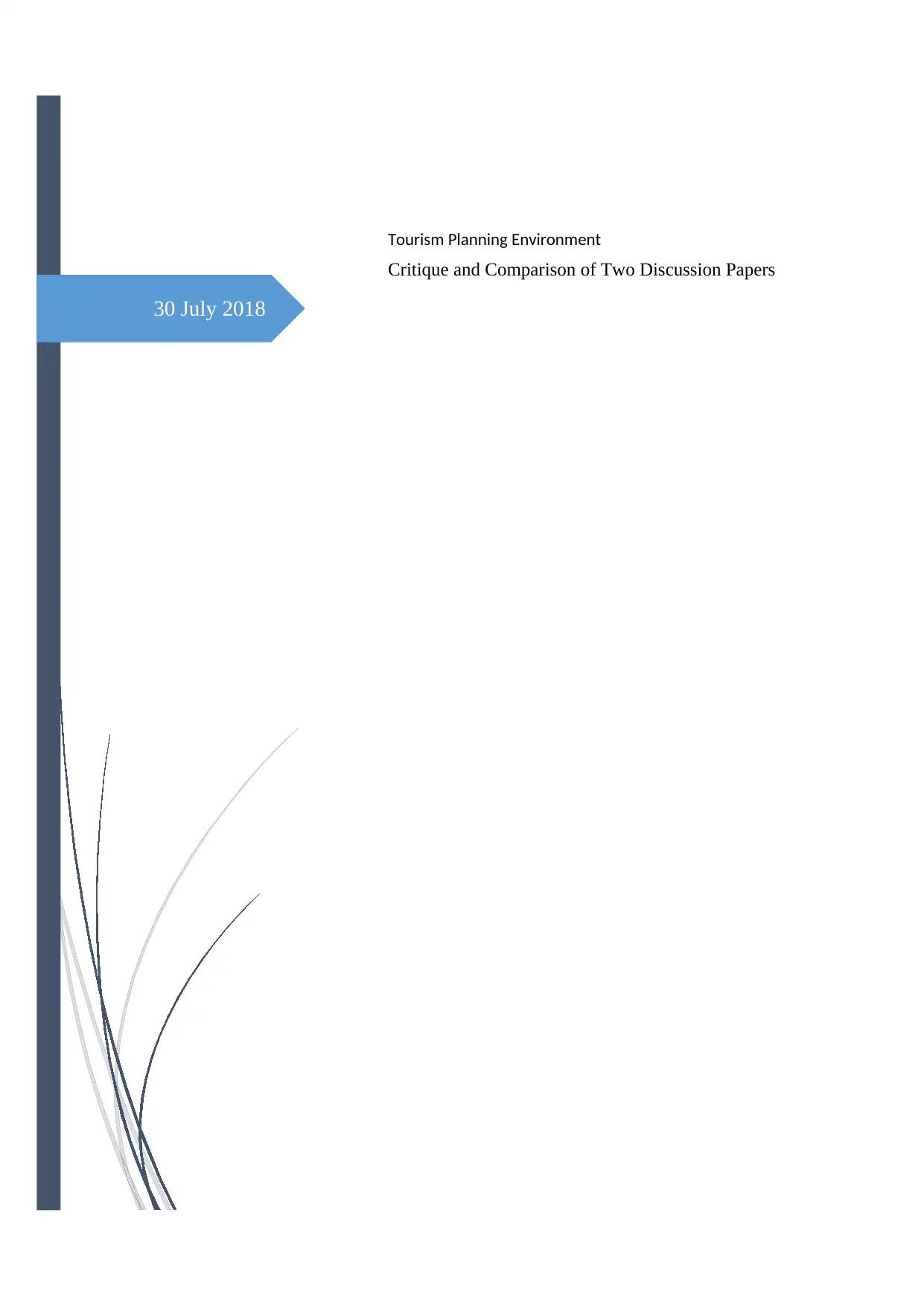
30 July 2018
Tourism Planning Environment
Critique and Comparison of Two Discussion Papers
Tourism Planning Environment
Critique and Comparison of Two Discussion Papers
Paraphrase This Document
Need a fresh take? Get an instant paraphrase of this document with our AI Paraphraser
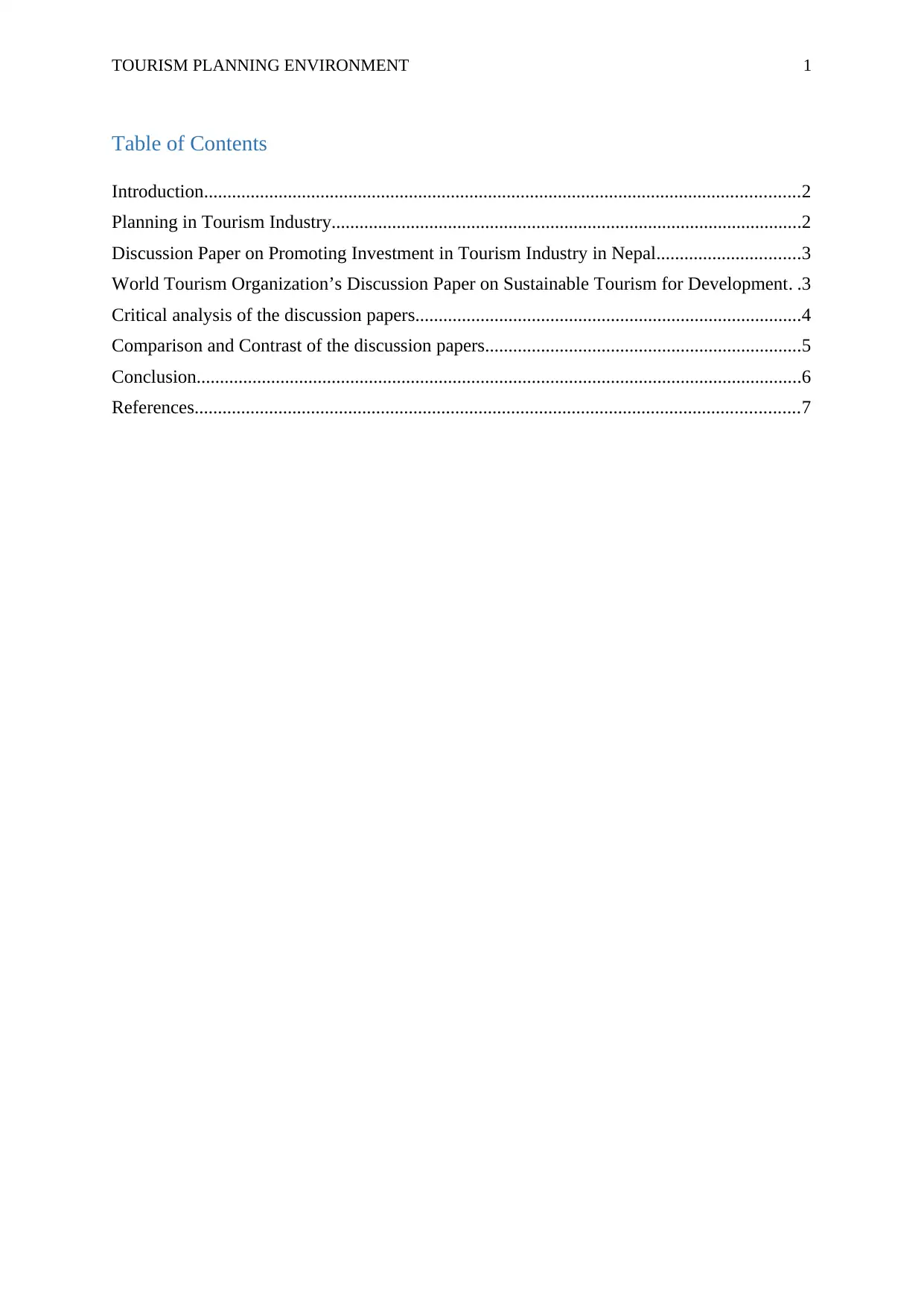
TOURISM PLANNING ENVIRONMENT 1
Table of Contents
Introduction................................................................................................................................2
Planning in Tourism Industry.....................................................................................................2
Discussion Paper on Promoting Investment in Tourism Industry in Nepal...............................3
World Tourism Organization’s Discussion Paper on Sustainable Tourism for Development. .3
Critical analysis of the discussion papers...................................................................................4
Comparison and Contrast of the discussion papers....................................................................5
Conclusion..................................................................................................................................6
References..................................................................................................................................7
Table of Contents
Introduction................................................................................................................................2
Planning in Tourism Industry.....................................................................................................2
Discussion Paper on Promoting Investment in Tourism Industry in Nepal...............................3
World Tourism Organization’s Discussion Paper on Sustainable Tourism for Development. .3
Critical analysis of the discussion papers...................................................................................4
Comparison and Contrast of the discussion papers....................................................................5
Conclusion..................................................................................................................................6
References..................................................................................................................................7
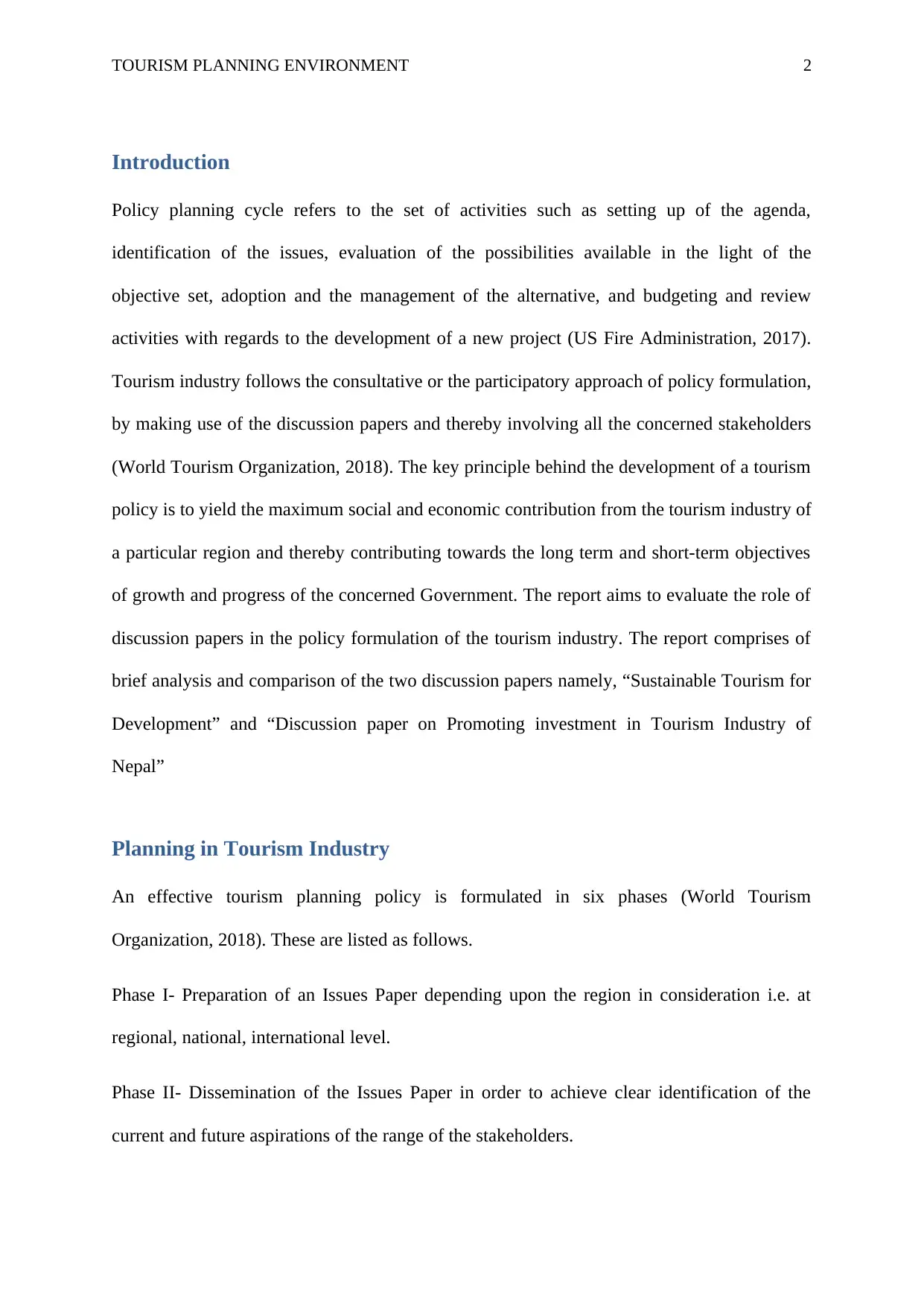
TOURISM PLANNING ENVIRONMENT 2
Introduction
Policy planning cycle refers to the set of activities such as setting up of the agenda,
identification of the issues, evaluation of the possibilities available in the light of the
objective set, adoption and the management of the alternative, and budgeting and review
activities with regards to the development of a new project (US Fire Administration, 2017).
Tourism industry follows the consultative or the participatory approach of policy formulation,
by making use of the discussion papers and thereby involving all the concerned stakeholders
(World Tourism Organization, 2018). The key principle behind the development of a tourism
policy is to yield the maximum social and economic contribution from the tourism industry of
a particular region and thereby contributing towards the long term and short-term objectives
of growth and progress of the concerned Government. The report aims to evaluate the role of
discussion papers in the policy formulation of the tourism industry. The report comprises of
brief analysis and comparison of the two discussion papers namely, “Sustainable Tourism for
Development” and “Discussion paper on Promoting investment in Tourism Industry of
Nepal”
Planning in Tourism Industry
An effective tourism planning policy is formulated in six phases (World Tourism
Organization, 2018). These are listed as follows.
Phase I- Preparation of an Issues Paper depending upon the region in consideration i.e. at
regional, national, international level.
Phase II- Dissemination of the Issues Paper in order to achieve clear identification of the
current and future aspirations of the range of the stakeholders.
Introduction
Policy planning cycle refers to the set of activities such as setting up of the agenda,
identification of the issues, evaluation of the possibilities available in the light of the
objective set, adoption and the management of the alternative, and budgeting and review
activities with regards to the development of a new project (US Fire Administration, 2017).
Tourism industry follows the consultative or the participatory approach of policy formulation,
by making use of the discussion papers and thereby involving all the concerned stakeholders
(World Tourism Organization, 2018). The key principle behind the development of a tourism
policy is to yield the maximum social and economic contribution from the tourism industry of
a particular region and thereby contributing towards the long term and short-term objectives
of growth and progress of the concerned Government. The report aims to evaluate the role of
discussion papers in the policy formulation of the tourism industry. The report comprises of
brief analysis and comparison of the two discussion papers namely, “Sustainable Tourism for
Development” and “Discussion paper on Promoting investment in Tourism Industry of
Nepal”
Planning in Tourism Industry
An effective tourism planning policy is formulated in six phases (World Tourism
Organization, 2018). These are listed as follows.
Phase I- Preparation of an Issues Paper depending upon the region in consideration i.e. at
regional, national, international level.
Phase II- Dissemination of the Issues Paper in order to achieve clear identification of the
current and future aspirations of the range of the stakeholders.
⊘ This is a preview!⊘
Do you want full access?
Subscribe today to unlock all pages.

Trusted by 1+ million students worldwide
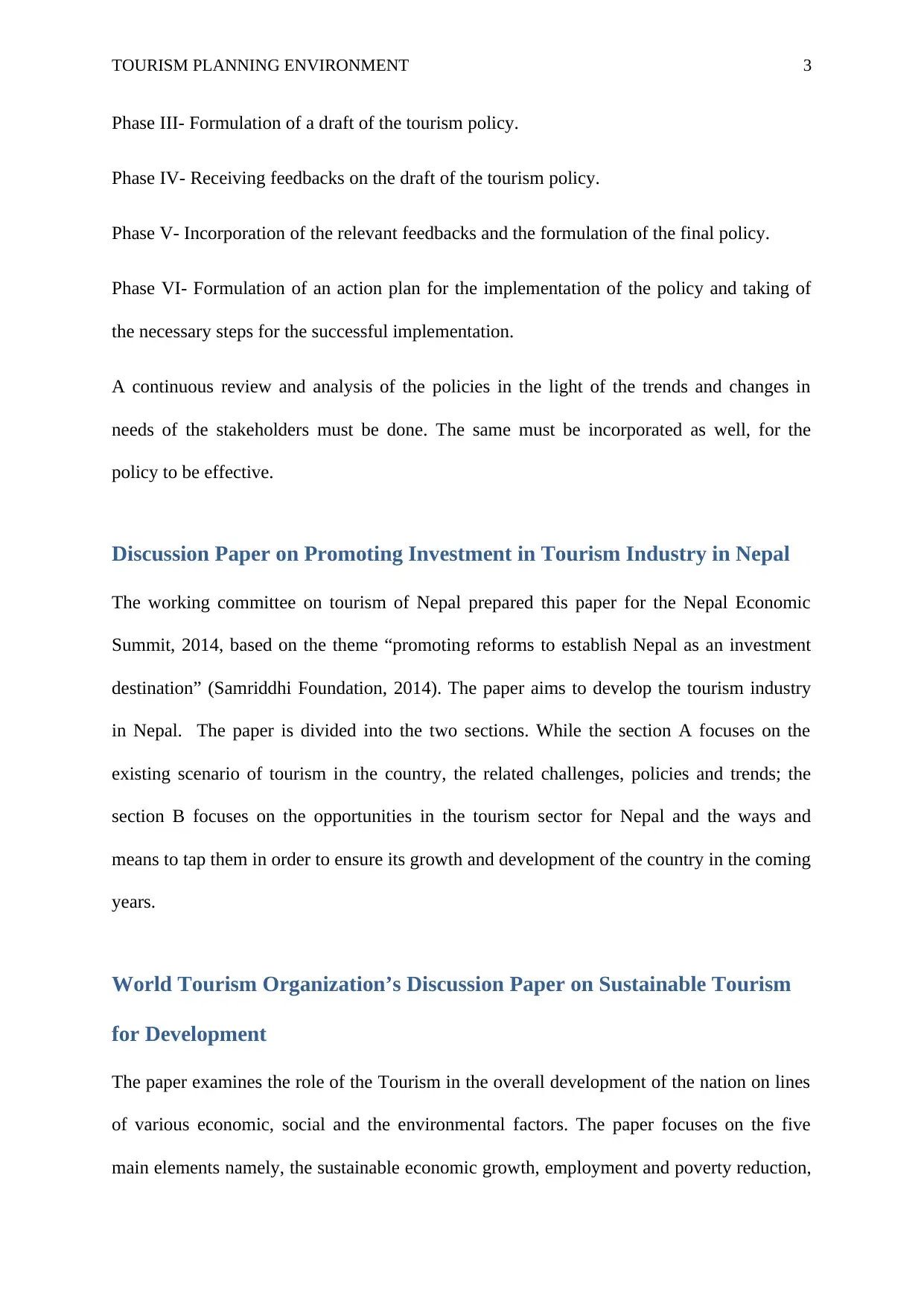
TOURISM PLANNING ENVIRONMENT 3
Phase III- Formulation of a draft of the tourism policy.
Phase IV- Receiving feedbacks on the draft of the tourism policy.
Phase V- Incorporation of the relevant feedbacks and the formulation of the final policy.
Phase VI- Formulation of an action plan for the implementation of the policy and taking of
the necessary steps for the successful implementation.
A continuous review and analysis of the policies in the light of the trends and changes in
needs of the stakeholders must be done. The same must be incorporated as well, for the
policy to be effective.
Discussion Paper on Promoting Investment in Tourism Industry in Nepal
The working committee on tourism of Nepal prepared this paper for the Nepal Economic
Summit, 2014, based on the theme “promoting reforms to establish Nepal as an investment
destination” (Samriddhi Foundation, 2014). The paper aims to develop the tourism industry
in Nepal. The paper is divided into the two sections. While the section A focuses on the
existing scenario of tourism in the country, the related challenges, policies and trends; the
section B focuses on the opportunities in the tourism sector for Nepal and the ways and
means to tap them in order to ensure its growth and development of the country in the coming
years.
World Tourism Organization’s Discussion Paper on Sustainable Tourism
for Development
The paper examines the role of the Tourism in the overall development of the nation on lines
of various economic, social and the environmental factors. The paper focuses on the five
main elements namely, the sustainable economic growth, employment and poverty reduction,
Phase III- Formulation of a draft of the tourism policy.
Phase IV- Receiving feedbacks on the draft of the tourism policy.
Phase V- Incorporation of the relevant feedbacks and the formulation of the final policy.
Phase VI- Formulation of an action plan for the implementation of the policy and taking of
the necessary steps for the successful implementation.
A continuous review and analysis of the policies in the light of the trends and changes in
needs of the stakeholders must be done. The same must be incorporated as well, for the
policy to be effective.
Discussion Paper on Promoting Investment in Tourism Industry in Nepal
The working committee on tourism of Nepal prepared this paper for the Nepal Economic
Summit, 2014, based on the theme “promoting reforms to establish Nepal as an investment
destination” (Samriddhi Foundation, 2014). The paper aims to develop the tourism industry
in Nepal. The paper is divided into the two sections. While the section A focuses on the
existing scenario of tourism in the country, the related challenges, policies and trends; the
section B focuses on the opportunities in the tourism sector for Nepal and the ways and
means to tap them in order to ensure its growth and development of the country in the coming
years.
World Tourism Organization’s Discussion Paper on Sustainable Tourism
for Development
The paper examines the role of the Tourism in the overall development of the nation on lines
of various economic, social and the environmental factors. The paper focuses on the five
main elements namely, the sustainable economic growth, employment and poverty reduction,
Paraphrase This Document
Need a fresh take? Get an instant paraphrase of this document with our AI Paraphraser
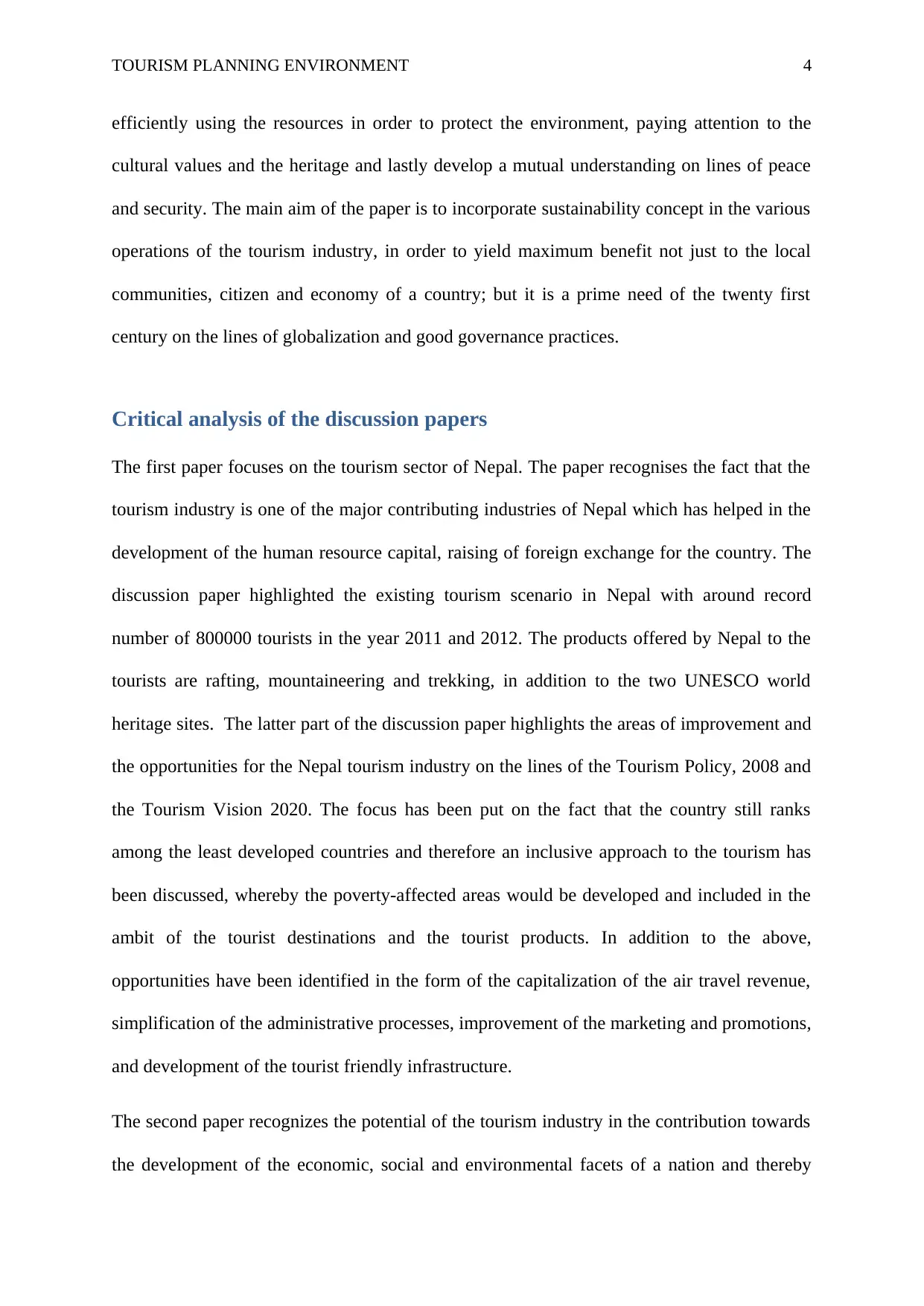
TOURISM PLANNING ENVIRONMENT 4
efficiently using the resources in order to protect the environment, paying attention to the
cultural values and the heritage and lastly develop a mutual understanding on lines of peace
and security. The main aim of the paper is to incorporate sustainability concept in the various
operations of the tourism industry, in order to yield maximum benefit not just to the local
communities, citizen and economy of a country; but it is a prime need of the twenty first
century on the lines of globalization and good governance practices.
Critical analysis of the discussion papers
The first paper focuses on the tourism sector of Nepal. The paper recognises the fact that the
tourism industry is one of the major contributing industries of Nepal which has helped in the
development of the human resource capital, raising of foreign exchange for the country. The
discussion paper highlighted the existing tourism scenario in Nepal with around record
number of 800000 tourists in the year 2011 and 2012. The products offered by Nepal to the
tourists are rafting, mountaineering and trekking, in addition to the two UNESCO world
heritage sites. The latter part of the discussion paper highlights the areas of improvement and
the opportunities for the Nepal tourism industry on the lines of the Tourism Policy, 2008 and
the Tourism Vision 2020. The focus has been put on the fact that the country still ranks
among the least developed countries and therefore an inclusive approach to the tourism has
been discussed, whereby the poverty-affected areas would be developed and included in the
ambit of the tourist destinations and the tourist products. In addition to the above,
opportunities have been identified in the form of the capitalization of the air travel revenue,
simplification of the administrative processes, improvement of the marketing and promotions,
and development of the tourist friendly infrastructure.
The second paper recognizes the potential of the tourism industry in the contribution towards
the development of the economic, social and environmental facets of a nation and thereby
efficiently using the resources in order to protect the environment, paying attention to the
cultural values and the heritage and lastly develop a mutual understanding on lines of peace
and security. The main aim of the paper is to incorporate sustainability concept in the various
operations of the tourism industry, in order to yield maximum benefit not just to the local
communities, citizen and economy of a country; but it is a prime need of the twenty first
century on the lines of globalization and good governance practices.
Critical analysis of the discussion papers
The first paper focuses on the tourism sector of Nepal. The paper recognises the fact that the
tourism industry is one of the major contributing industries of Nepal which has helped in the
development of the human resource capital, raising of foreign exchange for the country. The
discussion paper highlighted the existing tourism scenario in Nepal with around record
number of 800000 tourists in the year 2011 and 2012. The products offered by Nepal to the
tourists are rafting, mountaineering and trekking, in addition to the two UNESCO world
heritage sites. The latter part of the discussion paper highlights the areas of improvement and
the opportunities for the Nepal tourism industry on the lines of the Tourism Policy, 2008 and
the Tourism Vision 2020. The focus has been put on the fact that the country still ranks
among the least developed countries and therefore an inclusive approach to the tourism has
been discussed, whereby the poverty-affected areas would be developed and included in the
ambit of the tourist destinations and the tourist products. In addition to the above,
opportunities have been identified in the form of the capitalization of the air travel revenue,
simplification of the administrative processes, improvement of the marketing and promotions,
and development of the tourist friendly infrastructure.
The second paper recognizes the potential of the tourism industry in the contribution towards
the development of the economic, social and environmental facets of a nation and thereby
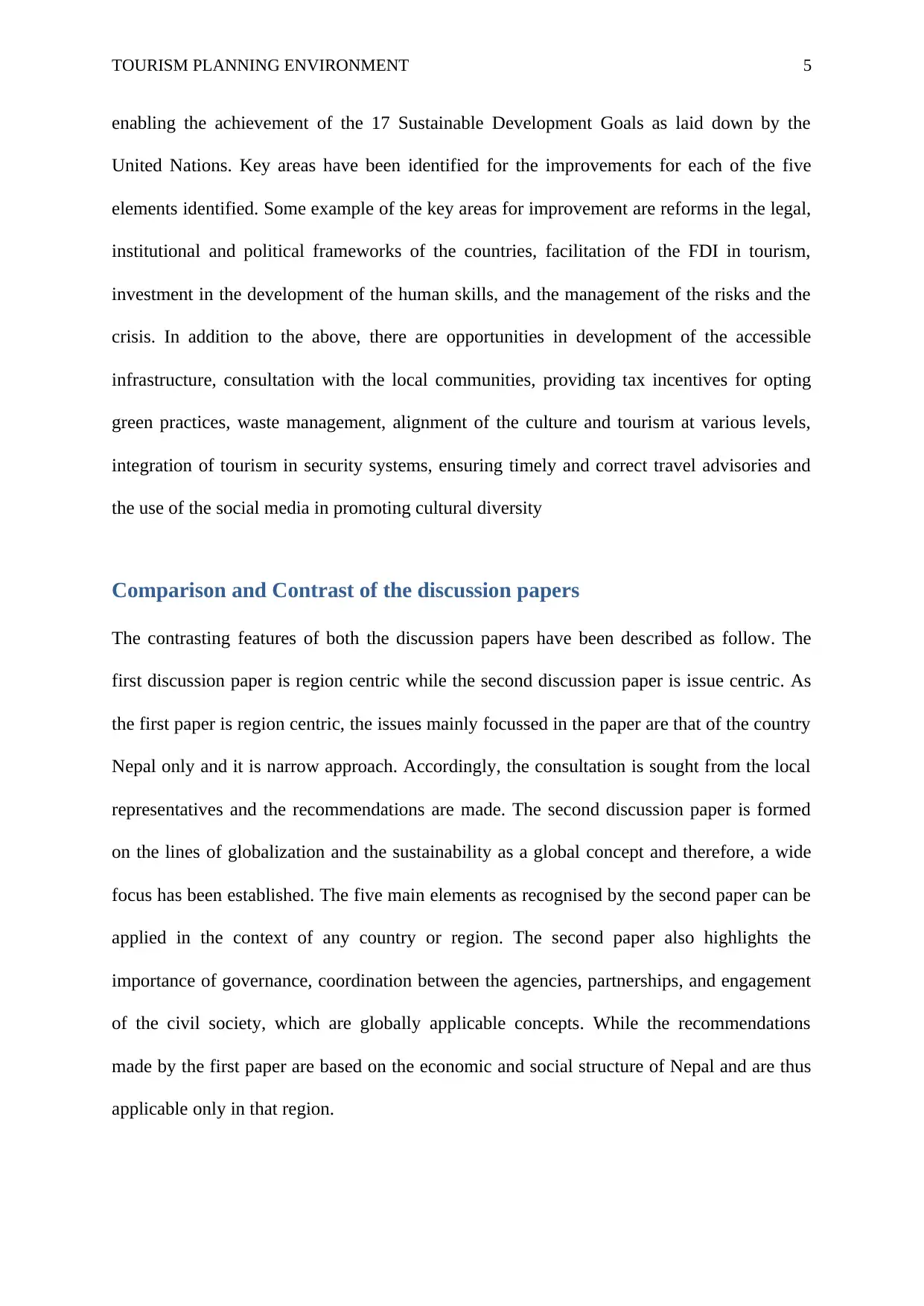
TOURISM PLANNING ENVIRONMENT 5
enabling the achievement of the 17 Sustainable Development Goals as laid down by the
United Nations. Key areas have been identified for the improvements for each of the five
elements identified. Some example of the key areas for improvement are reforms in the legal,
institutional and political frameworks of the countries, facilitation of the FDI in tourism,
investment in the development of the human skills, and the management of the risks and the
crisis. In addition to the above, there are opportunities in development of the accessible
infrastructure, consultation with the local communities, providing tax incentives for opting
green practices, waste management, alignment of the culture and tourism at various levels,
integration of tourism in security systems, ensuring timely and correct travel advisories and
the use of the social media in promoting cultural diversity
Comparison and Contrast of the discussion papers
The contrasting features of both the discussion papers have been described as follow. The
first discussion paper is region centric while the second discussion paper is issue centric. As
the first paper is region centric, the issues mainly focussed in the paper are that of the country
Nepal only and it is narrow approach. Accordingly, the consultation is sought from the local
representatives and the recommendations are made. The second discussion paper is formed
on the lines of globalization and the sustainability as a global concept and therefore, a wide
focus has been established. The five main elements as recognised by the second paper can be
applied in the context of any country or region. The second paper also highlights the
importance of governance, coordination between the agencies, partnerships, and engagement
of the civil society, which are globally applicable concepts. While the recommendations
made by the first paper are based on the economic and social structure of Nepal and are thus
applicable only in that region.
enabling the achievement of the 17 Sustainable Development Goals as laid down by the
United Nations. Key areas have been identified for the improvements for each of the five
elements identified. Some example of the key areas for improvement are reforms in the legal,
institutional and political frameworks of the countries, facilitation of the FDI in tourism,
investment in the development of the human skills, and the management of the risks and the
crisis. In addition to the above, there are opportunities in development of the accessible
infrastructure, consultation with the local communities, providing tax incentives for opting
green practices, waste management, alignment of the culture and tourism at various levels,
integration of tourism in security systems, ensuring timely and correct travel advisories and
the use of the social media in promoting cultural diversity
Comparison and Contrast of the discussion papers
The contrasting features of both the discussion papers have been described as follow. The
first discussion paper is region centric while the second discussion paper is issue centric. As
the first paper is region centric, the issues mainly focussed in the paper are that of the country
Nepal only and it is narrow approach. Accordingly, the consultation is sought from the local
representatives and the recommendations are made. The second discussion paper is formed
on the lines of globalization and the sustainability as a global concept and therefore, a wide
focus has been established. The five main elements as recognised by the second paper can be
applied in the context of any country or region. The second paper also highlights the
importance of governance, coordination between the agencies, partnerships, and engagement
of the civil society, which are globally applicable concepts. While the recommendations
made by the first paper are based on the economic and social structure of Nepal and are thus
applicable only in that region.
⊘ This is a preview!⊘
Do you want full access?
Subscribe today to unlock all pages.

Trusted by 1+ million students worldwide
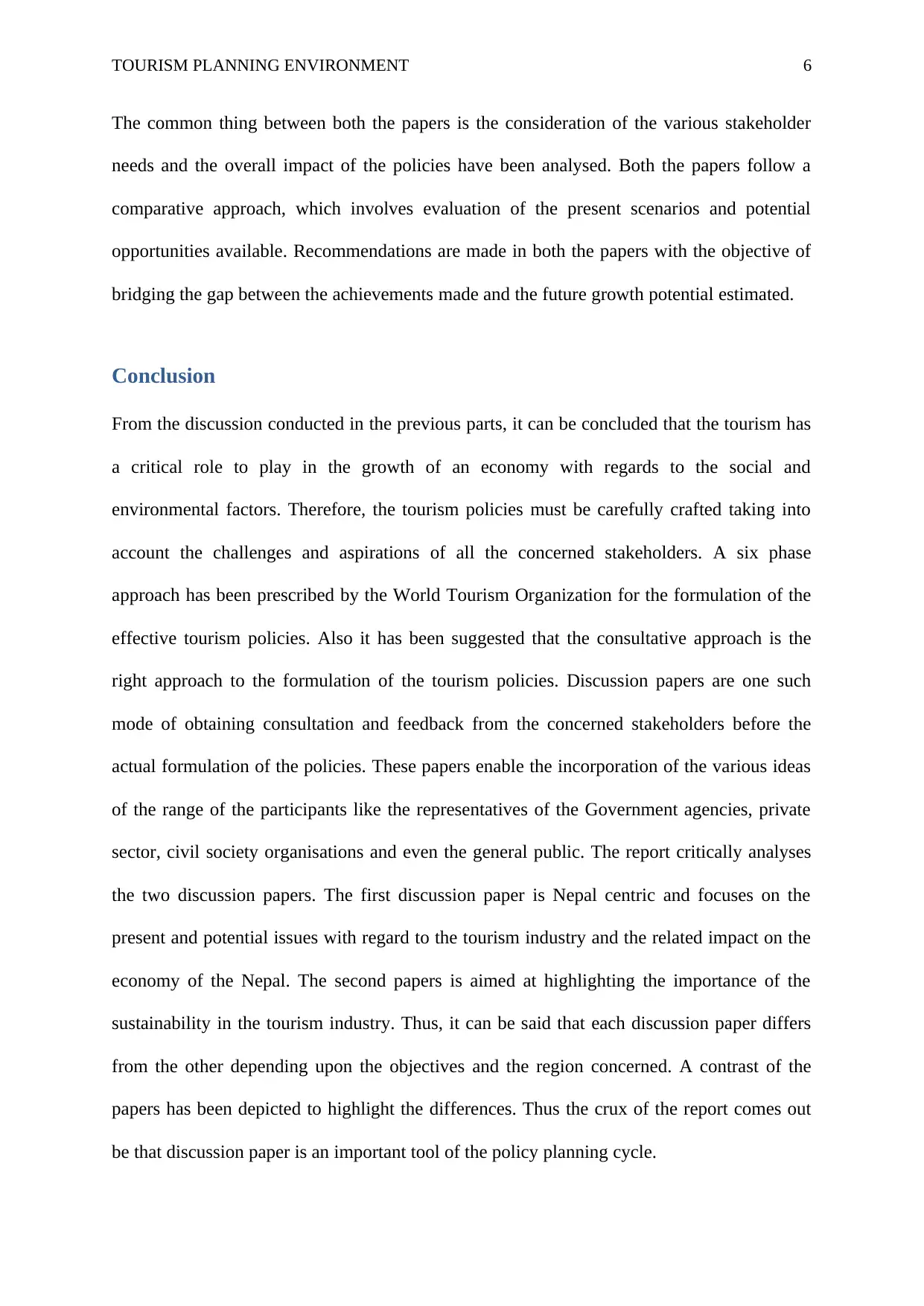
TOURISM PLANNING ENVIRONMENT 6
The common thing between both the papers is the consideration of the various stakeholder
needs and the overall impact of the policies have been analysed. Both the papers follow a
comparative approach, which involves evaluation of the present scenarios and potential
opportunities available. Recommendations are made in both the papers with the objective of
bridging the gap between the achievements made and the future growth potential estimated.
Conclusion
From the discussion conducted in the previous parts, it can be concluded that the tourism has
a critical role to play in the growth of an economy with regards to the social and
environmental factors. Therefore, the tourism policies must be carefully crafted taking into
account the challenges and aspirations of all the concerned stakeholders. A six phase
approach has been prescribed by the World Tourism Organization for the formulation of the
effective tourism policies. Also it has been suggested that the consultative approach is the
right approach to the formulation of the tourism policies. Discussion papers are one such
mode of obtaining consultation and feedback from the concerned stakeholders before the
actual formulation of the policies. These papers enable the incorporation of the various ideas
of the range of the participants like the representatives of the Government agencies, private
sector, civil society organisations and even the general public. The report critically analyses
the two discussion papers. The first discussion paper is Nepal centric and focuses on the
present and potential issues with regard to the tourism industry and the related impact on the
economy of the Nepal. The second papers is aimed at highlighting the importance of the
sustainability in the tourism industry. Thus, it can be said that each discussion paper differs
from the other depending upon the objectives and the region concerned. A contrast of the
papers has been depicted to highlight the differences. Thus the crux of the report comes out
be that discussion paper is an important tool of the policy planning cycle.
The common thing between both the papers is the consideration of the various stakeholder
needs and the overall impact of the policies have been analysed. Both the papers follow a
comparative approach, which involves evaluation of the present scenarios and potential
opportunities available. Recommendations are made in both the papers with the objective of
bridging the gap between the achievements made and the future growth potential estimated.
Conclusion
From the discussion conducted in the previous parts, it can be concluded that the tourism has
a critical role to play in the growth of an economy with regards to the social and
environmental factors. Therefore, the tourism policies must be carefully crafted taking into
account the challenges and aspirations of all the concerned stakeholders. A six phase
approach has been prescribed by the World Tourism Organization for the formulation of the
effective tourism policies. Also it has been suggested that the consultative approach is the
right approach to the formulation of the tourism policies. Discussion papers are one such
mode of obtaining consultation and feedback from the concerned stakeholders before the
actual formulation of the policies. These papers enable the incorporation of the various ideas
of the range of the participants like the representatives of the Government agencies, private
sector, civil society organisations and even the general public. The report critically analyses
the two discussion papers. The first discussion paper is Nepal centric and focuses on the
present and potential issues with regard to the tourism industry and the related impact on the
economy of the Nepal. The second papers is aimed at highlighting the importance of the
sustainability in the tourism industry. Thus, it can be said that each discussion paper differs
from the other depending upon the objectives and the region concerned. A contrast of the
papers has been depicted to highlight the differences. Thus the crux of the report comes out
be that discussion paper is an important tool of the policy planning cycle.
Paraphrase This Document
Need a fresh take? Get an instant paraphrase of this document with our AI Paraphraser
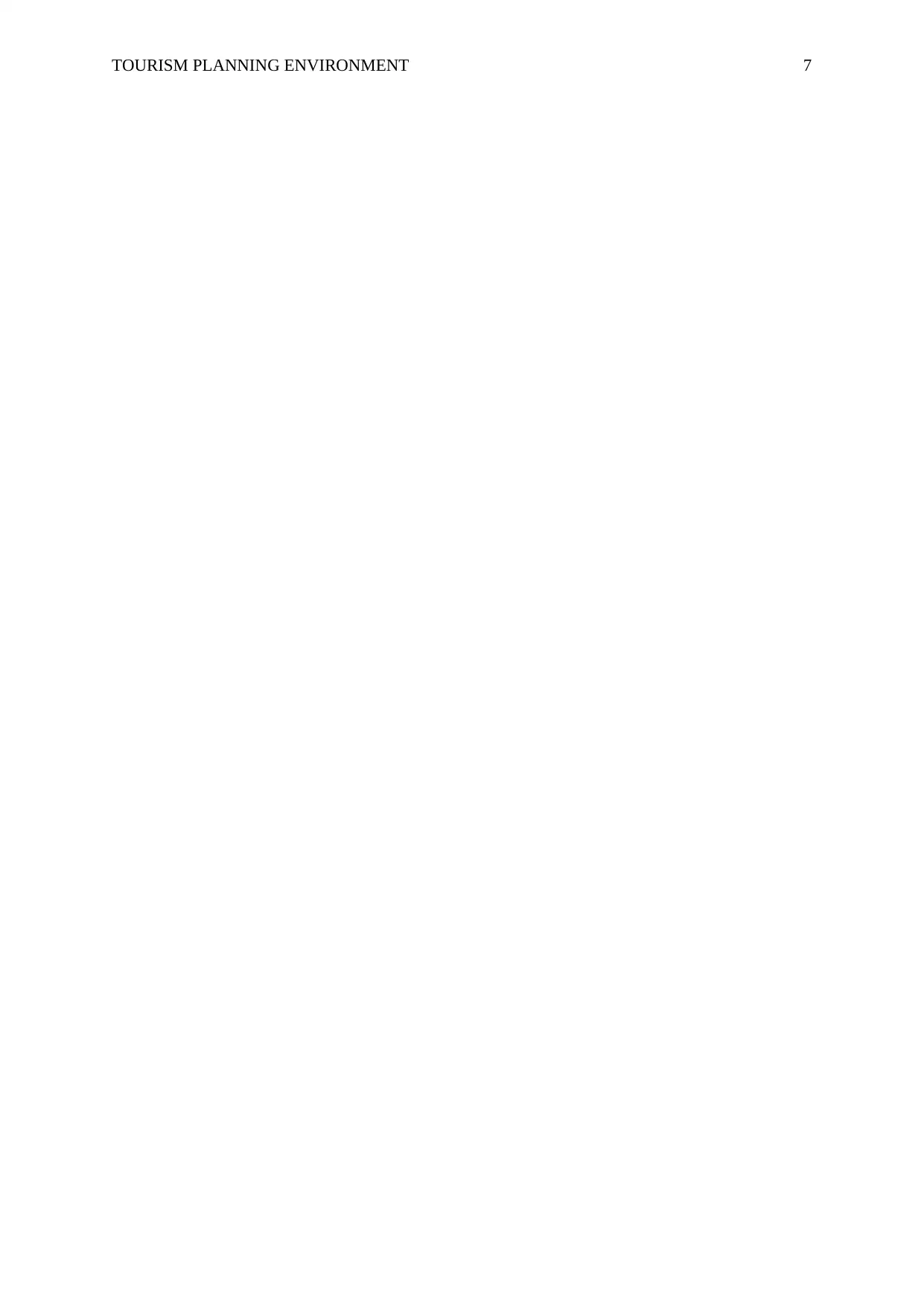
TOURISM PLANNING ENVIRONMENT 7
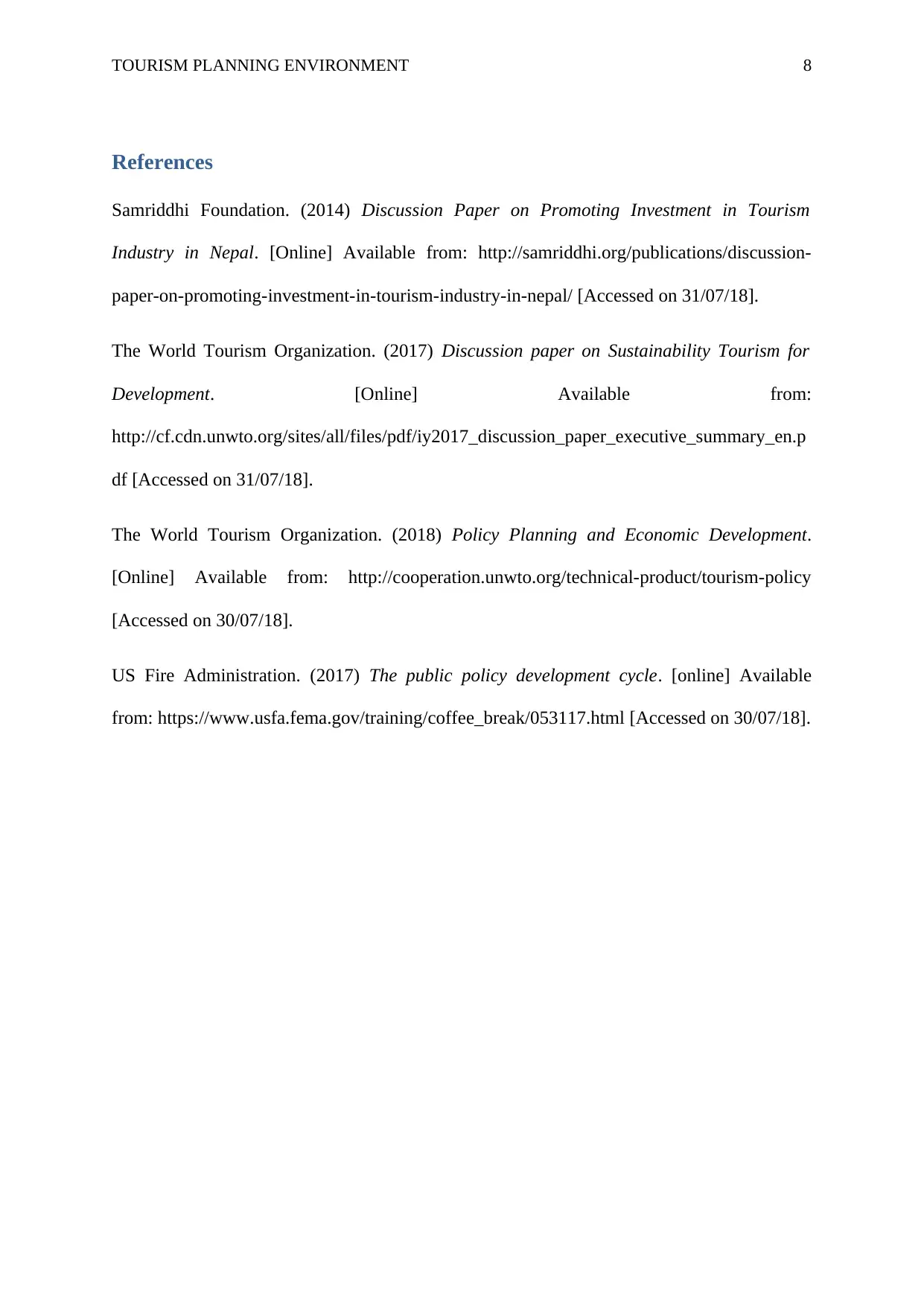
TOURISM PLANNING ENVIRONMENT 8
References
Samriddhi Foundation. (2014) Discussion Paper on Promoting Investment in Tourism
Industry in Nepal. [Online] Available from: http://samriddhi.org/publications/discussion-
paper-on-promoting-investment-in-tourism-industry-in-nepal/ [Accessed on 31/07/18].
The World Tourism Organization. (2017) Discussion paper on Sustainability Tourism for
Development. [Online] Available from:
http://cf.cdn.unwto.org/sites/all/files/pdf/iy2017_discussion_paper_executive_summary_en.p
df [Accessed on 31/07/18].
The World Tourism Organization. (2018) Policy Planning and Economic Development.
[Online] Available from: http://cooperation.unwto.org/technical-product/tourism-policy
[Accessed on 30/07/18].
US Fire Administration. (2017) The public policy development cycle. [online] Available
from: https://www.usfa.fema.gov/training/coffee_break/053117.html [Accessed on 30/07/18].
References
Samriddhi Foundation. (2014) Discussion Paper on Promoting Investment in Tourism
Industry in Nepal. [Online] Available from: http://samriddhi.org/publications/discussion-
paper-on-promoting-investment-in-tourism-industry-in-nepal/ [Accessed on 31/07/18].
The World Tourism Organization. (2017) Discussion paper on Sustainability Tourism for
Development. [Online] Available from:
http://cf.cdn.unwto.org/sites/all/files/pdf/iy2017_discussion_paper_executive_summary_en.p
df [Accessed on 31/07/18].
The World Tourism Organization. (2018) Policy Planning and Economic Development.
[Online] Available from: http://cooperation.unwto.org/technical-product/tourism-policy
[Accessed on 30/07/18].
US Fire Administration. (2017) The public policy development cycle. [online] Available
from: https://www.usfa.fema.gov/training/coffee_break/053117.html [Accessed on 30/07/18].
⊘ This is a preview!⊘
Do you want full access?
Subscribe today to unlock all pages.

Trusted by 1+ million students worldwide
1 out of 9
Related Documents
Your All-in-One AI-Powered Toolkit for Academic Success.
+13062052269
info@desklib.com
Available 24*7 on WhatsApp / Email
![[object Object]](/_next/static/media/star-bottom.7253800d.svg)
Unlock your academic potential
Copyright © 2020–2025 A2Z Services. All Rights Reserved. Developed and managed by ZUCOL.



